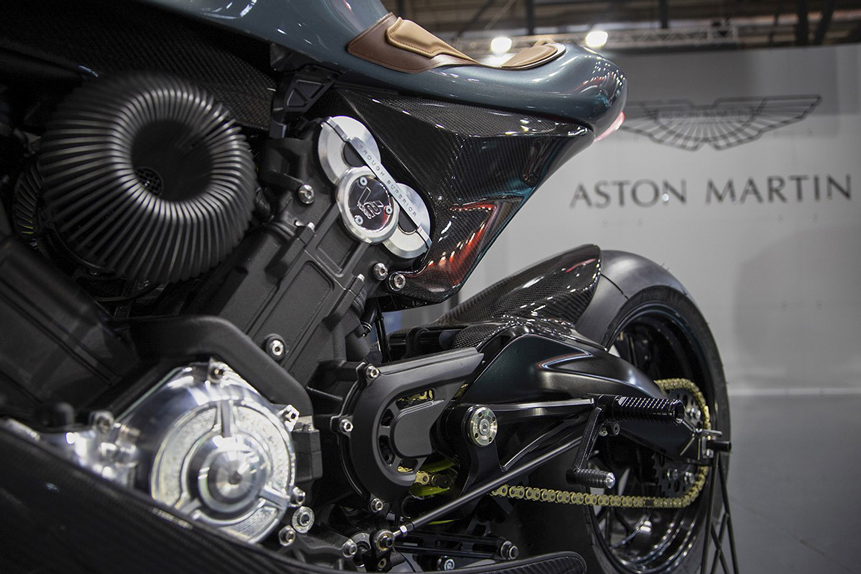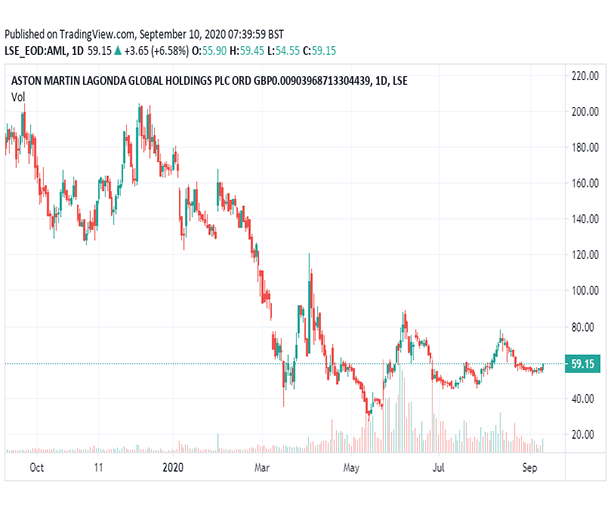
Thursday, September 10, 2020
What’s putting the brakes on Aston Martin’s share price?
By Century Financial in 'Brainy Bull'


Aston Martin’s [AML] share price hasn’t had the most comfortable of rides so far this year.
Aston Martin’s share price opened the year at 175.79p on 2 January before fears over its collapse due to weak sales and high debt levels left it struggling at 129.28p on 30 January.
A £182m equity investment by a consortium led by Lawrence Stroll, a Canadian billionaire who part-owns the Racing Point F1 team, saw Aston Martin’s share price recover to 160.13p by the end of the following day.
However, as the markets plunged due to coronavirus fears, Aston Martin’s share price fell 32% in February before dropping to a low of 46.18p on 16 March.
Aston Martin’s share price spluttered back into gear in April, climbing to 104.9p on 1 April as investors became more optimistic about the economic recovery post-lockdown. A £536m rights issue and Stroll becoming executive chairman also helped investor sentiment.
However, Aston Martin’s share price switched into reverse following worse-than-expected first-quarter results, dropping to 30.7p on 14 May. Since then, it's risen 83% to close at 56.3p on 7 September.


Widening losses reveal struggling half-year
Aston Martin reported an operating loss of £76.7m in the first quarter, up from a £3.2m loss in the same period last year. Revenue dropped 60% to £78.6m as it only sold 578 cars to dealers, down 45% year-over-year.
The British car manufacturer’s first-half results didn’t show much sign of improvement, after it posted an operating loss of £159.3m, up from a loss of £38.9m in 2019. Retail sales fell 41% and wholesale sales dropped 63%.


The group, which was valued at more than £5bn at its market debut in October 2018, has a market cap of just over £1bn.
Aston Martin’s share price was already in a weak position when it entered 2020. It has since been severely affected, like other manufacturers, by the coronavirus pandemic and the shuttering of dealerships and factories.
The company still has a substantial debt pile of £751m, and concerns of lowered consumer spending on luxury goods during a prolonged downturn also linger.
That said, Aston Martin remains positive under the leadership of Stroll and new chief executive Tobias Moers — formerly head of Mercedes-AMG. It is re-opening its dealerships and factories, seeing sales recover in China, and cutting costs by reducing production to ensure supply meets demand.
It has its first SUV, the DBX, starting production and hopes that the new Aston Martin Formula One team will give Aston Martin’s share price, profile and reputation a boost from next year.


Scripting a return to profit
Analysts are not convinced that Aston Martin’s share price will bounce back anytime soon. The consensus rating among those polled by MarketScreener is Underperform, although the average target for Aston Martin’s share price is 83.78p — a 48.8% increase on current levels (through 7 September’s close).
Rupert Hargreaves wrote in The Motley Fool, that Aston Martin is back on a firmer financial footing, which should “make it easier for the group to return to profit”.
“[Moers] is an industry insider … focusing on selling cars, rather than filling showrooms. Producing a limited amount of vehicles may result in higher selling prices and more demand. This could help fuel the company’s turnaround,” Hargreaves wrote.
He also believes that the DBX and its new Valkyrie hypercar will provide a cash-flow boost. “When sales start to roll the share price could jump,” he stated.
Ratings firm Standard & Poor’s also believes that Aston Martin is no longer vulnerable to a liquidity crisis over the next 12 months thanks to its capital raise and support from the British government’s Coronavirus Large Business Interruption Loan Scheme.


However, it added that the group’s free operating cash flow would remain “significantly negative” in 2020.
“The economic uncertainty caused by the COVID-19 pandemic still affected the group. It has subdued sales and production rates, as well as continued high cash burn,” the ratings firm noted.
Source: This content has been produced by Opto trading intelligence for Century Financial and was originally published on cmcmarkets.com/en-gb/opto
Disclaimer: Past performance is not a reliable indicator of future results.
The material (whether or not it states any opinions) is for general information purposes only and does not take into account your personal circumstances or objectives. Nothing in this material is (or should be considered to be) financial, investment or other advice on which reliance should be placed. No opinion given in the material constitutes a recommendation by Century Financial or the author that any particular investment, security, transaction or investment strategy is suitable for any specific person.
Century Financial does not endorse or offer opinion on the trading strategies used by the author. Their trading strategies do not guarantee any return and Century Financial shall not be held responsible for any loss that you may incur, either directly or indirectly, arising from any investment based on any information contained herein.















